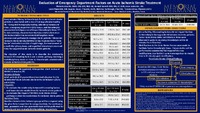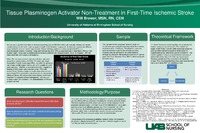Evaluation of emergency department factors on acute ischemic stroke treatment
View File(s)
- Author(s)
- Details
-
Melanie Aluotto, MSN, RN, CEN; Terence Chau, PharmD, BCPS; Nicholas Yarbrough, PharmD; Sapana Desai, PharD, BCPS; Donald Garrett, BSN, RN, CEN, LP; Huy Liem Pham, BSN, RN; Jesus Ledesma, RN
- Sigma Affiliation
- Non-member
Visitor Statistics
Visits vs Downloads
Visitors - World Map
Top Visiting Countries
| Country | Visits |
|---|
Top Visiting Cities
| City | Visits |
|---|
Visits (last 6 months)
Downloads (last 6 months)
Popular Works for Aluotto, Melanie by View
| Title | Page Views |
|---|
Popular Works for Aluotto, Melanie by Download
| Title | Downloads |
|---|
View Citations
Citations
Poster presentation Session A presented Thursday, September 14, 2017
Purpose: The objective of the study was to describe the relationship between emergency department factors and the timing of thrombolytic administration for acute ischemic stroke patients presenting to a community emergency department. Memorial Hermann Memorial City Emergency Department implemented a “Code Stroke” alert which consists of rapid triage, the involvement of a multi-disciplinary team, and expedited laboratory turnaround times for suspected acute ischemic stroke patients.
Design: This study was an IRB-approved retrospective quality assurance project of Memorial Hermann Memorial City’s Code Stroke pathway.
Setting: The retrospective chart review was conducted at Memorial Hermann Memorial City Medical Center in Houston, Texas. Memorial Hermann Memorial City is a 479-bed community hospital with a designation as a Primary Stroke Center.
Participants/Subjects: Inclusion criteria included adult patients (≥18 years old) with a primary or secondary diagnosis of ischemic stroke and received alteplase for the treatment of acute ischemic stroke at Memorial Hermann Memorial City Medical Center Emergency Department between 2/1/2011 and 9/1/2015. Exclusion criteria included patients < 18 years old, alteplase administration for the treatment of indications other than acute ischemic stroke, and pregnancy.n=148.
Methods: Data collection was performed from the patient’s electronic medical record. Data collected included but was not limited to: patient demographics, patient clinical data, and ED crowding factors. ED crowding factors included but was not limited to: total number of ED patients; number of treated ED patients; number of admitted ED patients; ED patient complexity; number of ED admits; admission percentage; time between arrival to triage and provider assignment.
The primary endpoint of the study was to evaluate the relationship between emergency department factors and lower door-to-thrombolytic times for acute ischemic stroke patients. Secondary endpoints were to evaluate the impact of Memorial Hermann Memorial City’s Code Stroke clinical pathway on door-to-thrombolytic times for acute ischemic stroke patients and the impact of the inclusion of emergency department clinical pharmacy services and phlebotomists (i.e. multi-disciplinary approach) on door-to-thrombolytic times less than 60 minutes.
Results/Outcomes: Data collection is ongoing. Preliminary results are presented. A total of 148 patients were included in the study. Between patients with door-to-needle times 60 minutes versus patients with door-to-needle times > 60 minutes, there were no significant differences in the measured daily ED crowding factors (door to triage, ED volume, number of treated patients, patient complexity, number of admissions, admission percentage, arrival to triage, arrival to bed, arrival to provider assignment, arrival to admission, arrival to discharge/depart).
Implications: Research is ongoing. Future directions include continuation of data collection and analysis of the final results. The final data will assist in the identification of areas for improvement. Preliminary data suggest the current Code Stroke pathway and its associated door-to-needle times are not impacted by daily ED crowding factors.
ENA 2017: Education, Networking, Advocacy. Held at America's Center Convention Center, St. Louis, Missouri, USA
Items submitted to a conference/event were evaluated/peer-reviewed at the time of abstract submission to the event. No other peer-review was provided prior to submission to the Henderson Repository, unless otherwise noted.
| Type | Poster |
| Acquisition | Proxy-submission |
| Review Type | Abstract Review Only: Reviewed by Event Host |
| Format | Text-based Document |
| Evidence Level | N/A |
| Research Approach | N/A |
| Keywords | Stroke Treatment; Workflow; Emergency Department |
| Name | Emergency Nursing 2017 |
| Host | Emergency Nurses Association |
| Location | St. Louis, Missouri, USA |
| Date | 2017 |
All rights reserved by the author(s) and/or publisher(s) listed in this item record unless relinquished in whole or part by a rights notation or a Creative Commons License present in this item record.
All permission requests should be directed accordingly and not to the Sigma Repository.
All submitting authors or publishers have affirmed that when using material in their work where they do not own copyright, they have obtained permission of the copyright holder prior to submission and the rights holder has been acknowledged as necessary.
Related items
Showing items related by title, author, creator and subjects.
-
Tissue plasminogen activator non-treatment in first-time ischemic stroke
Brewer, Will E. (2015-01-15)Session presented on Friday, September 26, 2014: The purpose of this proposed qualitative research study is to evaluate physicians attitudes toward tPA and how their attitudes negate its use in first-time ischemic stroke ... -
Lipid profiles and associated symptoms and outcomes in acute ischemic stroke patients
Martha, SarahThe purpose of this study was to determine the feasibility of a 1-month protocol and to describe self-reported symptoms and their association to cognitive and functional outcomes in persons with acute ischemic stroke (AIS) ... -
IA thrombectomy nursing care for acute ischemic stroke in Taiwan
Lin, Ching-WeiHow to reduce the neurological impairment of acute ischemic stroke cases and improve the prognosis of neurological function to reduce the burden on families, society and the country is indeed a very important issue in ... -
Reduction of door-to-needle times in acute ischemic strokes
Traylor, Jessica; Greco, Lisa A.; Covanes, Amy; Richardson, John; Schaefle, JonPurpose: Our Emergency Department aims to exceed the goals of the American Heart Association and American Stroke Association national quality improvement initiative to improve acute ischemic stroke care. Our Emergency ... -
Improving ScannED medications
Cothran, Amanda; Harmon, Nicholas; Smith, Kevin Jr. (2017-12-04)Purpose: Barcode medication verification has been proven to be an effective safety measure to help prevent errors during medication administration. It is necessary to provide safe medication administration to ensure quality ...





